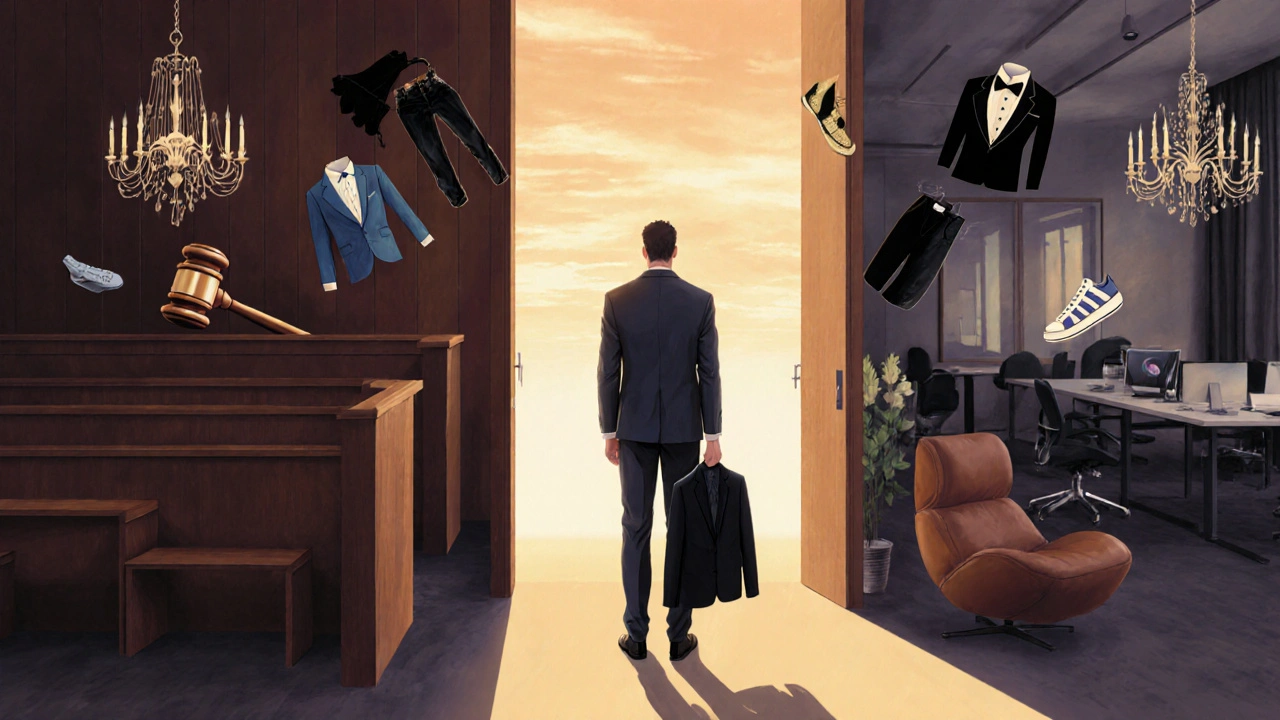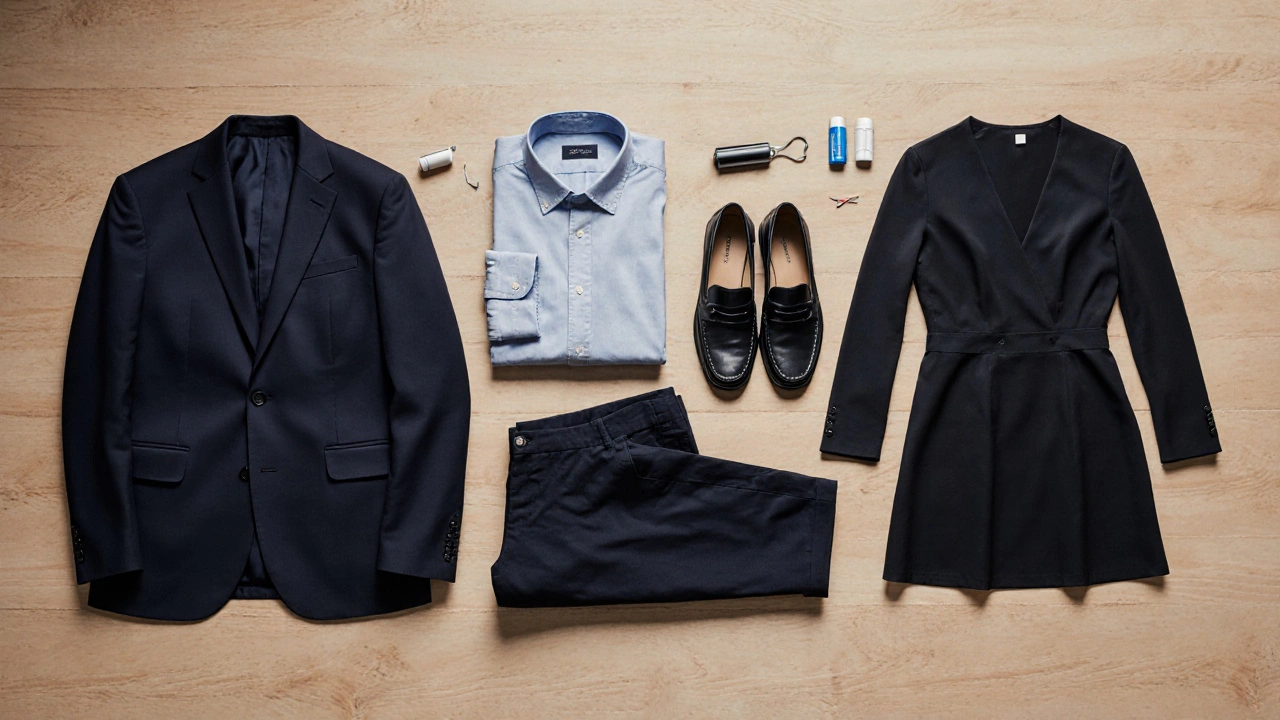Ever shown up to an event and felt like you were wearing the wrong thing? Not because it was dirty or torn, but because it just didn’t fit the room? That’s not bad taste-that’s a dress code mismatch. And it happens more often than you think.
Dress code rules aren’t about controlling you. They’re about signaling respect. They tell you what kind of energy to bring into a space. A courtroom, a startup office, a wedding, a job interview-each has its own unspoken language. And your clothes? They’re the first sentence you speak.
What Exactly Is a Dress Code Rule?
A dress code rule is a set of expectations-written or unwritten-about what clothing is appropriate for a specific place, event, or role. It’s not about fashion trends. It’s about context. It’s about knowing when to wear a blazer and when to wear jeans, even if both are clean and well-made.
These rules exist because people need to feel safe, respected, and aligned in shared environments. A law firm doesn’t want lawyers looking like they just came from a music festival. A tech startup doesn’t want employees looking like they’re heading to a funeral. Neither is about morality. It’s about culture.
Dress codes vary wildly. One company calls it “business casual.” Another calls it “professional attire.” But here’s the truth: those phrases mean different things in different places. That’s why understanding the dress code rule isn’t about memorizing terms-it’s about reading the room.
Common Dress Code Types and What They Actually Mean
You’ve seen these labels. But do you know what they mean in practice?
- Business Formal: Suit and tie for men. Pantsuit or dress with closed-toe heels for women. No exceptions. Think: courtrooms, high-level corporate meetings, black-tie galas.
- Business Professional: Same as above, but slightly less rigid. A blazer with dress pants or a skirt, button-down shirt, no tie required. Common in banks, law firms, government offices.
- Business Casual: This is the most misunderstood. It means no jeans, no sneakers, no hoodies. Think: chinos, polo shirts, blazers without ties, loafers. Women: tailored pants, knee-length dresses, flats or low heels. Avoid anything too tight, too short, or too loud.
- Casual: Jeans are allowed. T-shirts are fine. Sneakers? Yes. But “casual” doesn’t mean sloppy. No tank tops, no gym shorts, no flip-flops unless you’re at the beach. Even in casual workplaces, people notice if you look like you rolled out of bed.
- Smart Casual: The sweet spot. Think: dark jeans with a button-down shirt and a blazer. Or a dress with structured sandals. It’s polished but relaxed. Common in creative agencies, upscale restaurants, weekend events.
- Formal: Tuxedo, evening gown. Think: weddings, opera, award shows. This isn’t the same as business formal. Formal means evening wear, not office wear.
Here’s the trick: if you’re unsure, always lean one level up. It’s better to look overdressed than underdressed. People notice when you’re too casual. They rarely notice when you’re a little too sharp.
Workplace Dress Codes: The Real Rules No One Tells You
Most companies don’t hand out dress code manuals. They expect you to figure it out. Here’s how to do it without asking-because asking can make you look out of touch.
Look at the people who’ve been there the longest. Not the interns. Not the CEO. The mid-level managers. What are they wearing? That’s your baseline. If the senior designer shows up in jeans and a sweater, that’s your signal. If the finance director wears a suit every day, even on Friday, that’s your cue too.
Pay attention to the little things:
- Are people wearing socks with sandals? Probably not allowed.
- Do women wear open-toed shoes? Then you can too.
- Is there a hoodie culture? Maybe yes. But only if it’s a plain black one-not a giant logo.
Also, watch what happens on special days. Is there a “Casual Friday” policy? What does that look like? Some places let you wear jeans. Others say “no shorts, no graphic tees.” Don’t assume. Observe.
And here’s a real tip: if you’re new, ask a trusted colleague-not HR. HR will give you the policy. Your coworker will tell you what actually happens.

Special Events: Weddings, Interviews, Galas
Dress codes get even trickier outside the office.
Weddings often say “formal,” “semi-formal,” or “cocktail attire.” Here’s what that means:
- Formal: Long dress for women. Tuxedo for men.
- Semi-formal: Cocktail dress or suit without a tie.
- Cocktail attire: Short to mid-length dress, dressy separates, or a blazer with dress pants. No jeans. No sneakers.
Job interviews? Always go one step above the company’s usual dress code. If they’re business casual, wear a blazer. If they’re casual, wear slacks and a button-down. You’re not trying to impress with style-you’re trying to impress with professionalism.
Galas, fundraisers, award nights? Stick to the invitation. If it says “black tie,” wear a tux or evening gown. If it says “black tie optional,” you can wear a dark suit. But don’t show up in a suit if everyone else is in tuxedos. You’ll stand out-and not in a good way.
What Not to Wear (Even If It’s “Trendy”)
Just because something’s popular doesn’t mean it’s appropriate.
Here’s what never works in professional or formal settings:
- Jeans with holes
- Graphic tees with slogans or logos
- Sneakers (unless you’re in tech or a creative field that explicitly allows them)
- Flip-flops
- Overly tight or revealing clothing
- Heavy perfume or cologne
- Cluttered accessories
Even in casual settings, avoid looking like you didn’t try. A clean, well-fitting outfit-even if simple-says more than a flashy one that looks thrown together.
How to Master the Dress Code Without Stress
You don’t need a whole new wardrobe. You need a few key pieces and a smart system.
Build a core collection:
- One well-fitting navy or gray suit
- Two pairs of dark, non-distressed trousers
- Three button-down shirts (white, light blue, subtle stripe)
- One blazer (navy or black)
- One pair of closed-toe loafers or oxfords
- One knee-length dress (black or navy)
- One pair of low heels
That’s it. With these, you can handle 90% of situations. Mix and match. Add a scarf or a watch to change the vibe. No need to buy new clothes every season.
Also, keep a small “emergency kit” in your bag: a lint roller, safety pins, deodorant, and a spare pair of socks. You never know when you’ll spill coffee or get caught in rain.

Why Dress Code Rules Still Matter in 2025
Some people say dress codes are outdated. That we should just be ourselves.
But here’s the thing: you’re not just expressing yourself. You’re interacting with people who have expectations. And those expectations exist for a reason.
In New York, where I live, you see lawyers in suits, artists in vintage coats, nurses in scrubs, and delivery workers in branded uniforms. Each outfit tells a story. And when you show up in the wrong one, that story gets confused.
Dress codes aren’t about conformity. They’re about clarity. They help people know where they stand-without saying a word.
When you follow the rule, you’re not losing your identity. You’re gaining trust. You’re saying: I see this space. I respect it. I belong here.
Frequently Asked Questions
What if the dress code isn’t written down?
When there’s no official rule, look at what the people in charge are wearing. If you’re unsure, ask a coworker you trust-not HR. They’ll tell you the real standard, not the policy on paper.
Can I wear jeans to a business casual office?
It depends. In some places, dark, non-distressed jeans are fine. In others, they’re a hard no. Check if others wear them, and if they pair them with a blazer or button-down. If yes, you can too. If everyone wears chinos, skip the jeans.
Is it okay to wear sneakers to work?
Only if the workplace culture allows it-and even then, not all sneakers. Clean, minimalist white or black sneakers (like Common Projects or Allbirds) are usually fine in tech or creative fields. Avoid running shoes, bright colors, or ones with visible logos.
What should I wear to a job interview if I don’t have a suit?
Wear a blazer with dress pants or a skirt, a button-down shirt, and closed-toe shoes. If you don’t own a blazer, borrow one. Or buy a simple one from a thrift store for under $30. It’s an investment in your next job.
Do dress codes apply to remote workers?
Yes-for video calls. Even if you’re at home, your top half matters. Wear something professional from the waist up. A hoodie on Zoom looks unprofessional, even if you’re in pajama pants below. Treat video meetings like in-person ones.
Next Steps: How to Get It Right Every Time
Start tomorrow. Look at your closet. Pick one outfit you wear often. Ask yourself: Would this work in a job interview? At a client lunch? At a wedding?
If the answer is no, set it aside. Replace it with something that fits the rules.
You don’t need to buy everything at once. One new piece a month is enough. Focus on quality over quantity. A single well-fitting blazer can change how people see you.
Dress codes aren’t about restrictions. They’re about confidence. When you know what to wear, you stop worrying. And that’s when you start showing up as your best self.


Write a comment